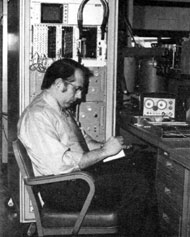NAL Group Builds Successful Beam Monitor System
The proton beam, for all its intensity and power, has often proved elusive, evading the clutches of even the most sophisticated control systems at the precise moment when it is to be studied. Largely unnoticed, in a corner of the Laboratory, a small group of people worked feverishly designing and constructing systems that measured quantitatively the size, position, and intensity of the beam produced by the NAL accelerator as it entered the various experimental areas. Their work was rewarded with a demonstration of their "beam profile monitoring and display system" in conjunction with proportional wire chambers and wire ionization chambers.
The group was under the direction of Fred Hornstra, electronics engineer in Research Services who later moved to the controls group of the Accelerator Section. Hornstra came to NAL in 1970 to head this development, following service as chief of operations at the ZGS external proton beam line at Argonne National Laboratory and at Los Alamos. The systems were built under the supervision of Technical Specialist Merle Haldeman, together with Maurice Harland, trainee. Greg Chartrand, technician, and Eddie Fuentes, another trainee, assisted in construction of the electronics. Marilyn Paul, secretary for the group, also helped in the lab.
"I was particularly impressed with the progress of our trainees," notes Hornstra. "Our group seems to have enjoyed the challenge of our project." Harland and Fuentes were members of the 1970 TAT class at NAL that received technical training at Oak Ridge, Tennessee.
Basically, the system worked as follows: Every time a particle went through the chamber, a wire received a pulse of charge. A counter and amplifier existed for each wire. The charge was amplified and sent to the miniature counter to be registered. After many counts, the contents of the counters were interrogated and displayed in a systematic manner. The wire which had the most counts appeared as the peak of a display on a screen, indicating the most intense portion of the beam. At each accelerator cycle, a new profile was generated and an analysis of the beam properties was displayed enabling operators to diagnose and alter the beam as desired.
Going one step further, an electronics engineer in the group, Ron Martin, designed an electronics system to link the proportional chambers to the computer control system in the beam line, so that the readings from the system could be viewed on a screen in the main control room in the Cross Gallery. In order to keep demand on the central computer to a minimum, Martin conceived and constructed a control which allows the detection system to operate without a computer. This he called CAMSAC, "Camac Stand Alone Controller."
This technically creative group also produced a system to monitor and display extracted proton beams as they were directed into experimental areas, a beam so intense that individual particles could not be counted. A somewhat simpler system was used to monitor such intense beams. Called SWIC (for segmented wire ion chamber), it collected the charge created by incidental beams without any amplification. The charge from each wire was stored on a corresponding capacitor and periodically the contents of the capacitor were interrogated and displayed on a screen.
Working on SWIC were Fuentes and J. Bondurant, with electronics designed by M. Haldeman and constructed by technician Steve Bjerklie.
All in all, this small group of people accomplished a lot in the past year.




